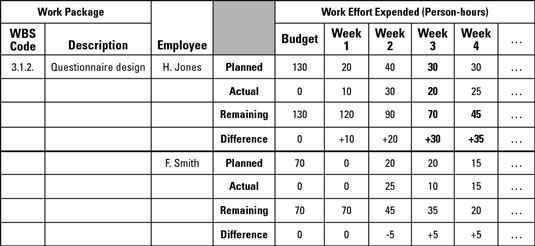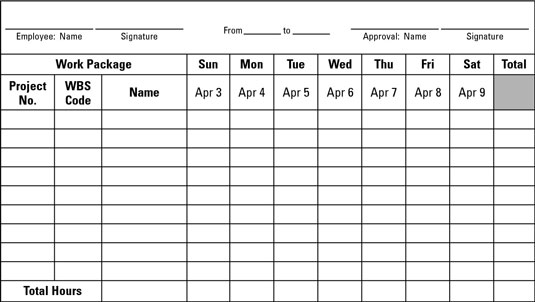When you're managing a project, comparing work effort expended with work effort planned can highlight when people are incorrectly expanding or reducing the scope of an activity; are more or less qualified than you anticipated; are encountering unexpected difficulties performing the work; or are in danger of using up allocated work effort before your project ends.
Monitoring work effort requires that you collect the actual effort spent on each work package or activity.
You begin by analyzing work effort expended. Evaluate your project’s work-effort expenditures by comparing the actual expenditures with those in your plan. The following information comes from your project plan:
The work package identifiers and names
The total hours budgeted for each team member to spend on each work package
The hours budgeted for each team member to spend on each work package every week
You obtain or derive the following information for the labor report from data during the period covered by the report:
The number of hours each team member spent on each work package
The number of hours left for each team member to spend on each work package
The difference between the number of hours in the plan and the number of hours each team member actually spent on each work package
 A typical labor report describes the work effort by each team member on each work package.
A typical labor report describes the work effort by each team member on each work package.
Actual labor expenditures rarely agree 100 percent with the planned amounts. Typically, variances of up to 10 percent above or below the expected numbers in any month are normal.
To collect work effort data have people fill out time sheets. You need to include the following information on each time sheet:
The number of hours a team member worked on each work package each day
The team member’s signature verifying that the information is correct
An approval signature (typically the project manager or someone he designates) verifying that the time charges are valid and appropriate
 Use a weekly time sheet to collect work effort data.
Use a weekly time sheet to collect work effort data.
Generally, recording work on activities to the nearest half-hour is sufficient.
Just as with schedule performance data, the more accurate your work-effort expenditure data are, the more meaningful your analyses will be. Take the following steps to increase the accuracy of the work-effort expenditure data you collect:
Explain to people that you’re using their labor-effort expenditures to help you determine when you may need to change aspects of the plan.
Encourage people to record the actual hours they work instead of making their total hours equal 40 hours per week.
Include categories for time on nonproject activities, such as unallocated, administrative overhead, and so on.
Encourage people to fill out their own time sheets.
Collect time sheets weekly, if possible, or at least once every two weeks.
Don’t ask people to submit their time sheets before the period is over.

